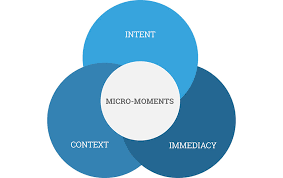In today’s high speed digital era, brands compete for attention in seconds. Modern consumers rarely follow a linear buyer’s journey. Instead, they rely on spontaneous searches and instant decisions. This is where Micro-Moments Marketing comes into play. These are the brief but crucial points in the customer journey when a person turns to their device, often a smartphone, to act on a need, whether to learn, purchase, perform, or proceed.
Companies can capture intent, establish trust, and turn interest into worthwhile actions by comprehending these real-time consumer behaviors. This blog will discuss what micro-moments are, why they are important, and how you should capitalize on them to improve your digital marketing strategy.
What Are Micro-Moments in Marketing?
Google presented the concept of micro-moments to describe the purposeful choices consumers make instantly online. Unlike traditional marketing pathways, micro-moments are not about extensive knowledge, they are about specific intent.

There are four primary types:
-
I-want-to-know moments
when a consumer seeks quick information.
-
I-want-to-go moments
when someone looks for a nearby product or service.
-
I-want-to-do moments
when users seek guidance on completing a task.
-
I-want-to-buy moments
when consumers are ready to purchase.
By focusing on these occurrences, brands can design individualized tactics to respond in real time.
Why Micro-Moments Matter in the Customer Journey
Modern consumers do not plan every step. They rely on mobile micro-moments marketing to make fast, informed decisions. Considering this, nearly 70% of smartphone users are more likely to buy from companies whose mobile web links their needs quickly.
When businesses align with consumer intent marketing, they establish their stance at the exact moment of decision-making. For example:
- A traveler searching for the best coffee near me (I-want-to-go).
- A user looking up how to steam vegetables quickly (I-want-to-do).
- A shopper typing affordable steamer cookware reviews 2026 (I-want-to-buy).
Each of these is a chance for a brand to connect, guide, and convert in the moment.
Strategies for Capturing Intent in Real Time
To maximize the benefits of Micro-Moments Marketing, brands must act quickly and correctly. Here are some effective strategies:
-
Optimize for Mobile
Since most micro-moments happen on smartphones, your website must load fast, be responsive, and provide seamless navigation. Slow load times can mean losing the customer instantly.
-
Use SEO to Match Search Intent
Using long-tail keywords and digital marketing micro-moments guarantees that your content is relevant to user searches. Trending queries can be found using tools like SEMrush and Google Keyword Planner.
-
Deliver Real-Time Engagement
Quick responses on chatbots, instant purchase options, or location-based ads allow you to capture real-time consumer behavior effectively.
-
Create Content for Each Micro-Moment
- Blog posts for I-want-to-know searches.
- Local landing pages for I-want-to-go.
- Tutorials and videos for I-want-to-do.
- Clear CTAs for I-want-to-buy.
-
Personalize with Data
Predict intent with analytics. For example, when there is a high number of people searching for the term best smart kitchen gadgets 2026, your brand must provide articles or advertisements to match that requirement.
Examples of Micro-Moments Strategy
Brands worldwide are mastering Google micro-moments strategy to drive conversions:
- Starbucks uses location-based notifications to suggest nearby outlets when consumers are searching for coffee near me.
- Amazon captures I-want-to-buy moments with one-click checkout and instant product recommendations.
- YouTube creators respond to I-want-to-do moments by publishing quick tutorials like how to cook with a steamer.
These examples prove that being present at micro-moments directly impacts sales and customer loyalty.
The Role of Real-Time Marketing
 Real-time marketing strategy is not about speed, it is about significance. When your brand answers consumer questions instantly, you are not just providing information, you are building credibility.
Real-time marketing strategy is not about speed, it is about significance. When your brand answers consumer questions instantly, you are not just providing information, you are building credibility.
Consider integrating tools such as:
- AI-powered chatbots for instant responses.
- Push notifications for location-specific offers.
- Dynamic ads based on browsing behavior.
The brands that succeed are those that modify to the customer’s moment of need.
How to Capture Consumer Intent Online
To succeed in Micro-Moments Marketing, businesses must align with both technology and psychology. Here is a step-by-step roadmap:
-
Identify micro-moment opportunities
Analyze search data to see when customers look for your products.
-
Map them to your content strategy
Align each stage of the journey with blogs, FAQs, and landing pages.
-
Prioritize speed & accessibility
A responsive mobile site is essential.
-
Measure success
Track conversions from mobile searches, clicks on local listings, or engagement with tutorials.
Future of Micro-Moments Marketing
Anticipating micro-moments in the customer journey will only become more vital. With 5G, voice search and AI assistance, customers anticipate responses in a matter of seconds. This means that marketers need to build campaigns that forecast intent before it occurs. For example, predictive AI might recommend content even before a user types a request for information, shifting from reactive to initiative-taking marketing.
Conclusion
Micro-Moments Marketing is no longer a trend; it is the future of digital engagement. By capturing consumer intent in real time, brands not only win sales but also create lasting trust. Companies that are adept at micro-moments will maintain their lead in the cutthroat digital market, from Data-Driven personalization to mobile optimization.
